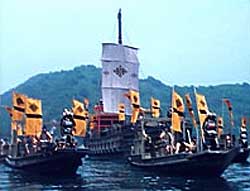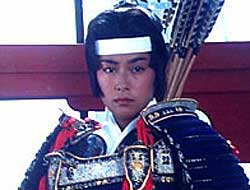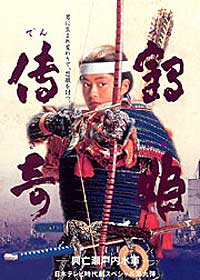Tsuruhime denki: Metsubo Setouchi suigun (Tale of the Crane Princess, Fate of Arms in the Seto Sea, 1993) is a cheapo historical adventure telefilm I turst was aimed at youth. It's utter lack of sophistication & its disdain for historicity would annoy anyone steeped in the good things of jidai-geki or samurai cinema.
 Midway through the Warring States era, an island clan off the coast of Mishima is struggling to preserve the independence from perpetually warring Japan, even if they can only do so through piratical activity. Midway through the Warring States era, an island clan off the coast of Mishima is struggling to preserve the independence from perpetually warring Japan, even if they can only do so through piratical activity.
Into a lineage of shrine priests descended of samurai is born a sacred daughter, when what was expected was a sacred son. This child was named Tsuruhime, the Crane Princess (Kumiko Goto).
For a film historically absurd, it spends a lot of time with tedious narration of the political situation year by year, while being awfully slow at developing characters.
The Crane Princess grows up a tomboy & believes her grampa to have become God of the Seto Sea. She is herself this Dragon God's messenger. Her messages, alas, are just additional reports on the political situation, further delaying getting down to anything with character or action in it.
As politics lead inexorably to war, further dull history lessons are provided. At long last the Crane Princess decides she, too, must fight. So her family locks her in storage house to keep her from doing un-girly stuff.
If this film had given a fig about Japanese history it wouldn't've had this samurai princess treated as a peculiarity who had to be locked up in the shed lest she try to be a hero. During the warring states period, all women of samurai class learned to fight, typically with naginata (halbard) & with bow & arrow, but also with swords & other weapons.
All such women were prepared at the very least to defend castles while the men were in the moving camps. So despite all the dull history lessons in this film, rendering it tedious, it gets very little of the social structure right.
When her brother dies in battle, only she is left as the incarnation of the Dragon God. Armor had long before been made just for her, at her late father's dictate, but had been kept hidden away. It is finally revealed, & her destiny can no longer be denied.
She sets out to save Omi Island from her peoples' enemies. And hooboy does look spilffy & hot-cha-cha all dressed up for battle. Too bad four-fifths of the film is such a tedious teledrama, as the star really looks her part, if only it had been better written.
 After establishing her warrior credentials, we still have to overlook the fact that the actress never even bothered to learn how to hold a bow & arrow correctly. After establishing her warrior credentials, we still have to overlook the fact that the actress never even bothered to learn how to hold a bow & arrow correctly.
At least we're going to see her in some sort of action, right? Wrong. It turns into a love story amidst wartime politics, with a tepid tragedy resulting, & a couple western kiss scenes, a courtship practice alien to Japan of that era.
In the climax the Crane Princess has her second warrior-posturing scene as "the Joan of Arc of Omishima." Throughout she remains onoy a symbolic figurehead not actually capable of anything.
To cement the thing in maximum absurdity, it ends with a supernatural sequence of Princess Tsuru's posthumous duel with her chief foe. How wacky she had to be dead to finally do something. She then gives a nice ghostly dance of victorious sadness. This part tries to be poetic & it might've succeeded if anything else in the film had in any way plausibly led up to this.
Although the climax is not all well staged, it was even so an almost-effective ending to an otherwise awful movie. Having almost no substance to back up its sentimentality, however, a last-minute dash for something worthwhile just doesn't make up for the rest.
copyright © by Paghat the Ratgirl
|

 Midway through the Warring States era, an island clan off the coast of Mishima is struggling to preserve the independence from perpetually warring Japan, even if they can only do so through piratical activity.
Midway through the Warring States era, an island clan off the coast of Mishima is struggling to preserve the independence from perpetually warring Japan, even if they can only do so through piratical activity. After establishing her warrior credentials, we still have to overlook the fact that the actress never even bothered to learn how to hold a bow & arrow correctly.
After establishing her warrior credentials, we still have to overlook the fact that the actress never even bothered to learn how to hold a bow & arrow correctly.